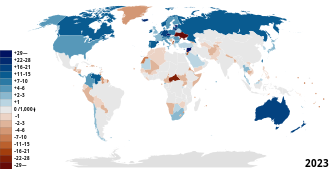Method
An excess of people entering a country is referred to as net immigration (e.g., 3.56 migrants/1,000 population). An excess of people leaving a country is referred to as net emigration (e.g., -9.26 migrants/1,000 population). The net migration rate indicates the contribution of migration to the overall level of population change. The net migration rate does not distinguish between economic migrants, refugees, and other types of migrants nor does it distinguish between lawful migrants and undocumented migrants. [1]
This page is based on this
Wikipedia article Text is available under the
CC BY-SA 4.0 license; additional terms may apply.
Images, videos and audio are available under their respective licenses.
